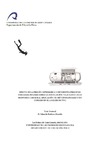Please use this identifier to cite or link to this item:
https://accedacris.ulpgc.es/jspui/handle/10553/7112
| Title: | Efecto de la presión hiperbárica y diferentes presiones parciales de gases sobre la modulación vegetativa de la respuesta cardiaca : aplicación de métodos lineales y no lineales en el análisis de VFC | Other Titles: | Effect of hyperbaric presure and different parial presure of gasis on the vegetative modulation of cardiac response: implementation of linear and non linear methods in the analysis of heart rote variability | Authors: | Barbosa Almeida, Eduardo | Director: | García Manso, Juan Manuel Martín González, Juan Manuel |
UNESCO Clasification: | 24 Ciencias de la vida 12 Matemáticas 2411 Fisiología humana 241103 Fisiología cardiovascular 120915 Series temporales, et al |
Keywords: | Fisiología del buceo Frecuencia cardiaca Oxigenación hiperbárica |
Issue Date: | 2011 | Abstract: | La exposición al medio hiperbárico conlleva importantes cambios en la respuesta funcional del organismo. Uno de los cambios más relevantes observados, en humanos, es la disminución de la Frecuencia Cardíaca (FC). El objetivo de este trabajo ha sido analizar la mecánica de disminución de la FC y evluar la importancia de los factores inherentes al aumento de la presión ambiental: presión parcial de oxígeno (Ppo2), densidad de los gases respirados, aumento de la temperatura ambiental y respiración de gases inertes. Para ello, hemos analizado la Variabilidad de la Frecuencia Cardíaca (VFC) en los dominios: frecuencia (Transformada Rápida de Fourier), tiempo/frecuencia (Transformadas Wavelet) y a través de una metodología no lineal (Plot de Poincaré). The hyperbaric exposure involves significant changes in the functional body response. A drop of Heart Rate (HR) is one of the most important physiological responses in these conditions. The aim was to analyze the mechanism of the drop of HRand evaluate the importance of the same normal factors in high environment pressure: Oxygen partial pressure (Ppo2), breath gas density, increase temperature and inert gas breath. Therefore, we analyzed the Heart Rate Variability (HRV) in the following domains: frequency (Fast Fourier Transform), time/frequency (Wavelet Transform) and by non lineal methodology (Poincaré Plot). |
Description: | Programa de doctorado: Actividad física, salud y rendimiento deportivo | Department: | Departamento de Educación Física | Faculty: | Facultad de Ciencias de la Actividad Física y el Deporte | URI: | https://accedacris.ulpgc.es/handle/10553/7112 | Rights: | by-nc-nd |
| Appears in Collections: | Tesis doctoral |
Page view(s)
902
checked on Jan 4, 2025
Download(s)
2,223
checked on Jan 4, 2025
Google ScholarTM
Check
Share
Export metadata
Items in accedaCRIS are protected by copyright, with all rights reserved, unless otherwise indicated.
